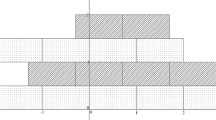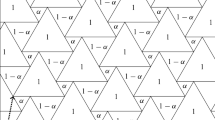Abstract
Let \({\varvec{a}}_1,\ldots , {\varvec{a}}_r\) be vectors in a half-space of \({\mathbb {R}}^n\). We call \(C={\varvec{a}}_1{\mathbb {R}}^{+}+\cdots +{\varvec{a}}_r {\mathbb {R}}^{+}\) a convex polyhedral cone and \(\{{\varvec{a}}_1,\ldots , {\varvec{a}}_r\}\) a generator set of C. A generator set with the minimal cardinality is called a frame. We investigate the translation tilings of convex polyhedral cones. Let \(T\subset {\mathbb {R}}^n\) be a compact set such that T is the closure of its interior, and \({{\mathcal {J}}}\subset {\mathbb {R}}^n\) be a discrete set. We say \((T,{{\mathcal {J}}})\) is a translation tiling of C if \(T+{{\mathcal {J}}}=C\) and any two translations of T in \(T+{{\mathcal {J}}}\) are disjoint in Lebesgue measure. We show that if the cardinality of a frame of C is larger than the dimension of C, then C does not admit any translation tiling; if the cardinality of a frame of C equals the dimension of C, then the translation tilings of C can be reduced to the translation tilings of \(({\mathbb {Z}}^+)^n\). As an application, we characterize all the self-affine tiles possessing polyhedral corners (that is, there exists a point of the tile such that a neighborhood of the point is congruent to a neighborhood of the vertex of a convex polyhedral cone), which generalizes a result of Odlyzko (Proc. Lond. Math. Soc. 37, 213–229 (1978)).




Similar content being viewed by others
References
Bandt, Ch.: Self-similar sets. V. Integer matrices and fractal tilings of \({\bf R}^n\). Proc. Amer. Math. Soc. 112(2), 549–562 (1991)
de Bruijn, N.G.: On number systems. Nieuw Arch. Wisk. 4, 15–17 (1956)
Davis, Ch.: Theory of positive linear dependence. Amer. J. Math. 76(4), 733–746 (1954)
Gerstenhaber, M.: Theory of convex polyhedral cones. Activity Analysis of Production and Allocation. Cowles Commission Monograph, vol. 13, pp. 298–316. Wiley, New York (1951)
Gröchenig, K., Haas, A.: Self-similar lattice tilings. J. Fourier Anal. Appl. 1(2), 131–170 (1994)
Grünbaum, B., Shephard, G.C.: Tilings and Patterns. W.H. Freeman and Company, New York (1987)
Hutchinson, J.E.: Fractals and self-similarity. Indiana Univ. Math. J. 30(5), 713–747 (1981)
Kenyon, R.: Self-replicating tilings. In: Symbolic Dynamics and Its Applications (New Haven 1991). Contemp. Math., vol. 135, pp. 239–263. Amer. Math. Soc., Providence (1992)
Kenyon, R.: Projecting the one-dimensional Sierpinski gasket. Israel J. Math. 97, 221–238 (1997)
Lagarias, J.C., Wang, Y.: Self-affine tiles in \({{\mathbb{R}}}^n\). Adv. Math. 121(1), 21–49 (1996)
Lagarias, J.C., Wang, Y.: Integral self-affine tiles in \({\mathbb{R}}^n\). I. Standard and nonstandard digit sets. J. London Math. Soc. 54(1), 161–179 (1996)
Lagarias, J.C., Wang, Y.: Integral self-affine tiles in \({\mathbb{R}}^n\). Part II: Lattice tilings. J. Fourier Anal. Appl. 3(1), 83–102 (1997)
Lai, Ch.-K., Lau, K.-S., Rao, H.: Spectral structure of digit sets of self-similar tiles on \({\mathbb{R}}^1\). Trans. Am. Math. Soc. 365(7), 3831–3850 (2013)
Lai, Ch.-K., Lau, K.-S., Rao, H.: Classification of tile digit sets as product-forms. Trans. Am. Math. Soc. 369(1), 623–644 (2017)
Lau, K.-S., Rao, H.: On one-dimensional self-similar tilings and \(pq\)-tiles. Trans. Amer. Math. Soc. 355(4), 1401–1414 (2003)
Niven, I.: A characterization of complementing sets of pairs of integers. Duke Math. J. 38, 193–203 (1971)
Odlyzko, A.M.: Non-negative digit sets in positional number systems. Proc. London Math. Soc. 37(2), 213–229 (1978)
Rao, H., Yang, Y.-M., Zhang, Y.: Characterization of complementing pairs of \((\mathbb{Z}_{\ge 0})^n\) (2020). arXiv:2005.09204
Rockafellar, R.T.: Convex Analysis Princeton Mathematical Series, vol. 28. Princeton University Press, Princeton (1970)
Vince, A.: Digit tiling of Euclidean space. In: Directions in Mathematical Quasicrystals. CRM Monogr. Ser., vol. 13, pp. 329–370. Amer. Math. Soc., Providence (2000)
Author information
Authors and Affiliations
Corresponding author
Additional information
Editor in Charge: Kenneth Clarkson
Publisher's Note
Springer Nature remains neutral with regard to jurisdictional claims in published maps and institutional affiliations.
This work is supported by NSFC Nos. 11431007, 11601172, 11971195, 12071167, and Fundamental Research Funds for Central Universities No. 2662015PY217, and Self-Determined Research Funds of CCNU from the Colleges’ Basic Research and Operation of MOE under Grant CCNU17XJ034.
Appendix A: Proof of Lemma 7.3
Appendix A: Proof of Lemma 7.3
Proof
For simplicity, we identify \({\mathbb {R}}^2\) with the complex plane \({\mathbb {C}}\). Let \(L_0=\{x+h {\mathbf {i}}:x\in [a,b]\}\). Assume that \(t_1, t_2,\ldots , t_p\) are points in L from left to right. Suppose on the contrary that \((T, \{t_0,t_1,\ldots , t_p\})\) is a tiling of A. Let
be a parallelogram on the left part of A. Clearly \(I\subset T\). Let M be the largest integer such that \(Mt_1<1\). We claim that \(T\cap \bigcup _{m=0}^{M-1}(I+mt_1)\) is a union of translations of I. To prove this, we need only prove the following two statements: for each integer m, \(0\le m\le M-1\), we have:
-
(i)
\({{\mathcal {J}}}\cap [0, mt_1]\subset t_1{\mathbb {Z}}^+\).
-
(ii)
For every integer \(0\le u\le m\), \(I+ut_1\) belongs to one tile except a measure zero set.
We prove (i) and (ii) by induction on m. Clearly, (i) and (ii) hold for \(m=0\). Now we assume that (i) and (ii) hold for \(m-1\) with \(m\ge 1\).
First, we prove (i). If \(t\in {{\mathcal {J}}}\cap [0, mt_1)\), then \(t+I\) and \(\bigcup _{j=0}^{m-1}(I+jt_1)\) overlap, we have \(t\notin ((m-1)t_1,mt_1)\) by the induction hypothesis of (ii). Therefore, by the induction hypothesis of (i), no matter \(mt_1\in {{\mathcal {J}}}\) or not, (i) holds for m.
Now we prove (ii). Suppose on the contrary that (ii) is false. Then \(I+mt_1\) does not belong to one tile. This first implies that \(mt_1\notin {{\mathcal {J}}}\). Secondly, if there exists \(1\le m'\le m-1\), such that \(m't_1\in {{\mathcal {J}}}\) and \(0<\mu ((T+m't_1)\cap (I+mt_1))<\mu (I)\), then \(0<\mu (T\cap (I+(m-m')t_1))<\mu (I)\), which contradicts the assumption (ii). Therefore, if a tile \(T+t\) satisfies that \(0<\mu ((T+t)\cap (I+mt_1))<\mu (I)\), then either \(t=0\), or \(mt_1<t<(m+1)t_1\). In the latter case, there is only one t satisfying this property, and we denote it by \(t^*\). Then
Denote \(U=\{x+y(a+h{\mathbf {i}}):x\in [mt_1,t^*),\,y\in [0,1]\}\). By \(U\cap (T+t^*)=\emptyset \) and the above equation, we have \(U\subset T\). Then the intersection of \(T+t_1\) and \(T+t^*\) contains \(U+t_1\) as a subset, which is a contradiction. So (ii) holds for m.
Since \(t_p\) is the rightmost point of \({{\mathcal {J}}}\), \(T+t_p\) must contain a relative neighborhood \(B(1,r)\cap A\) of 1, for all small enough r (\(<1-Mt_1\)). Moreover, we have \( B(1,r)\cap A=(T+t_p)\cap B(1,r)\), thus
On the other hand, since \(0\le 1-t_p\le Mt_1\) and \(T\cap \bigcup _{m=0}^{M-1}(I+mt_1)\) is a union of translations of I, then for small enough r, \(T\cap B(1-t_p,r)\) is a half-ball or a translation of \(I\cap B(0,r)\), or a translation of \(I\cap B(t_1,r)\), which contradicts with the shape of \(T\cap B(1-t_p,r)\) in (A.1). The lemma is proven. \(\square \)
Rights and permissions
About this article
Cite this article
Yang, Ym., Zhang, Y. Tilings of Convex Polyhedral Cones and Topological Properties of Self-Affine Tiles. Discrete Comput Geom 66, 876–901 (2021). https://doi.org/10.1007/s00454-020-00249-1
Received:
Revised:
Accepted:
Published:
Issue Date:
DOI: https://doi.org/10.1007/s00454-020-00249-1




